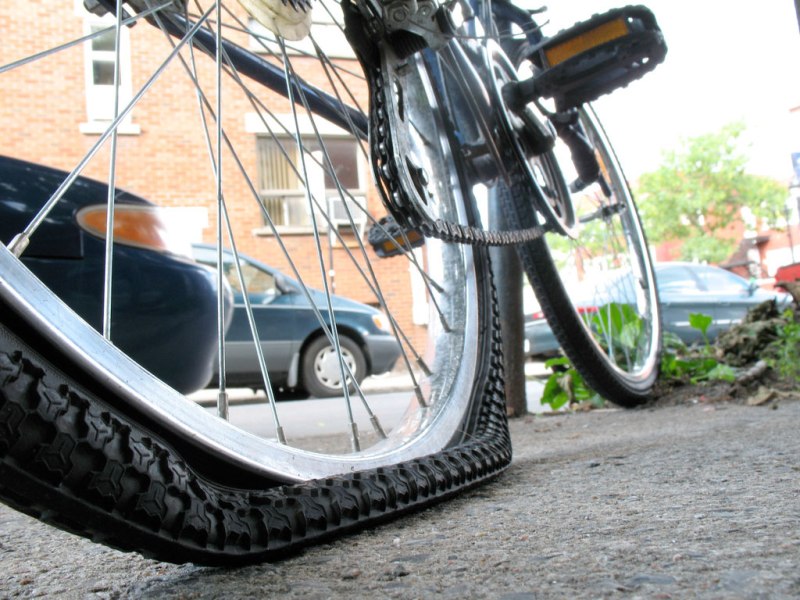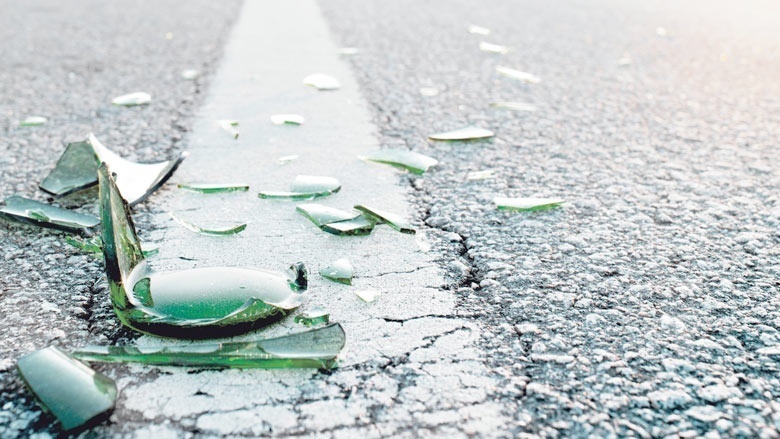Some biking issues never go away; ever since Adam & Eve first rode a Raleigh 20 we’ve all suffered from the occasional flat tyre. So how to minimise punctures, and what to do if you do get one? This blogpost, originally from July 2013, gives you some advice…
It seems to be a perennial problem these days, the prevalence of broken glass (or other detritus) on the streets and the subsequent punctures that can result. It’s a pain for the amount of inconvenience this causes, so what can be done to minimise the problem? (or deal with it when it happens…)

Step one is to try to eliminate the source of the problem from the roads and paths. Christchurch City Council has a regular programme of sweeping main cycleways, but of course it can never be everywhere at once. If you see glass or similar hazards somewhere in the way of cyclists, contact the Council to get it removed (see our previous post about this). If there is a particular safety issue (e.g. forces cyclists to swerve into traffic), let them know too so that they can make it a priority to sort out; they’re usually fairly good in this instance.
Keep a constant look out for glass, etc ahead of you when you’re riding; this is where a sunny day or good bike lights can help make it “shine out” more clearly. Near a construction site, the culprit may be more likely to be stray builder’s nails or screws. If you’re leading some others on a ride and you see some hazard, make sure that you clearly point and call out so that the following crowd don’t plough straight into it.
Note that not all glass is the same when it comes to punctures. If it’s toughened “safety glass”, say from a car window in a crash, then generally it shouldn’t cause too many problems. The main risk comes from ordinary glass of the kind found in broken bottles and side mirrors, which typically produce more hazardous shards.

Just to confuse you, some of the fancy new coloured surfaces also incorporate crushed glass or similar shiny aggregates in them. So while you might think you’re approaching a sea of dangerous glass on that green cycle lane, the “sparkle” is probably meant to be there.
So, other than trying to avoid the glass and stuff, how else can you prevent punctures?
- The simplest precaution is to ensure that your tyres are always properly inflated. Many punctures are actually “pinch flats” caused by insufficient air pressure in your tube; they get squeezed in the wrong place on the wheel rim and… pop! They often look like snake bites, with two puncture holes side by side.
- Sometimes sharp debris might stick to your tyre and then slowly work its way in later. So about once a week it probably pays to check over your tyres to remove any foreign objects that shouldn’t be there.
- Rubber is also more likely to be cut (and debris more likely to stick) when a bit of moisture is present, so don’t be surprised if you seem to get more punctures when riding in the wet than the dry (seems like a Murphy’s Law).
- If your tyres are starting to get thin with minimal tread left, then they’re at greater risk of letting something get through. So make sure you replace your worn tyres before it’s too late.
- You could splash out on tougher bike tyres. There are all sorts of fancy Kevlar tyres and other toughened materials out in the market. You can even get tubeless tyres, so that you don’t even have to worry about a conventional “flat”. You just have to do the economics of whether the extra cost is worth the saving in time, hassle, and tubes…
- If you find that punctures (or sometimes just slow leaks) are becoming an all-too common occurrence, consider simply getting some tougher inner tubes. A pair of “thorn-resistant” tubes or similar appear to be well worth the investment in reduced downtime (I’ve seen them for just $12-14 at K-Mart). Unlike my previous regular punctures, since I swapped my tubes to these, the only thing to defeat them has been a 4-inch builder’s nail! Even when glass has got through the tyre, the thicker tube wall often mean that it doesn’t get any further.
- Still others swear by “self-healing” tubes, which are essentially goo-filled tubes that block up the leaks when there’s a puncture. I tried them once myself and didn’t find them particularly effective (and rather messy). But they might block things well enough to pump up the tyre again and get you home in time before they go flat again (I suppose the sealant leaking out could also be handy to help find the puncture in the first place).
So if you do get a puncture, what are your options?
- You could repair the puncture if you carry a little repair kit with you. Typically there’s a special “glue” and various rubber patches to put on the errant cut on your tube. Some now are even simpler, working like pre-glued “bandaids” to just stick on instantly (usually not as permanent as the traditional patch though).

- You could swap out the damaged tube for a spare one. I usually carry a spare tube in my pannier, as well as some tyre levers to get the tyre off and a pump to get it pumped back up again. If time is of the essence, this is usually quicker than repairing the existing tube (which you could do later from the comforts of home). And by the time you’ve put the fifth patch on the same tube, it’s probably overdue to replace it anyway…
- If you’re really short of puncture-fixing gear on you then I’ve heard people try using newspaper or even grass as a temporary filling in the tyre to at least get home…
- If you’re near a handy bus route, you could just call it quits and put your bike on the bus rack to get you home or to your destination. Sometimes it’s just easier…
- If you’re not prepared for one of the above options, then steel yourself for a long awkward walk with your bike (punctured tyres never roll well…), or hope that you can get hold of someone who can give you and your bike a lift. Hmm, I’m an AA member; I wonder if their breakdown service would pick me up…
Now obviously if you’ve never tried to change your tube before or mend a puncture then some practice might be in order before needing to try it out for real in the field. There are a few fiddly bits to getting a wheel off from under the brake-pads and possibly a chain as well. Thankfully there are lots of helpful guides on the internet, like here and here. So study up and have a go; with practice, changing a tube can be less than 10 minutes work.
{Or you could come along to one of the ICECycles or RAD Bikes bike maintenance sessions and the friendly folk there can help show you through the basics…}
Watch out for the “gotcha”s with punctures, e.g. make sure that whatever caused the puncture in the first place is truly gone from your tyre (hint: a small rag is probably better than your unguarded finger for checking for stray shards!). And check that there isn’t more than one entry wound; if you rode over a real minefield of sharp stuff it could be that you’ve been stung multiple times. Also be careful about using tyre levers to put a tyre back on the wheel rim (could pinch it); sometimes it’s safer to just use your fingers.
After all this advice and the best precautions in the world, sometimes punctures still just happen, that’s life. It’s a small (and hopefully rare) price to pay for the benefits that cycling brings!
What’s your top tips for dealing with punctures?

My top tip for dealing with punctures is to pick up any glass bottles I see dropped on the road or cycleways. It takes just a few seconds, and might save a fellow cyclist (or my future self!) a whole lot of time and inconvenience by preventing a puncture. S
Also, the container deposit legislation that the Ministry for the Environment is working on would surely see far less broken glass around, by financially incentivising the return/recycling of glass bottles like back in the old days! https://www.mfe.govt.nz/news-events/beverage-container-return-scheme-under-development
I had never thought about picking up bottles, great idea. I always try to clean the scene after I see bottles smashed on the cycle path but preventing that they will get smashed in the first place is obviously much better.
Bring on the deposit scheme, long overdue as far as I am concerned!
Yes, I once came across a smashed bottle on the Northern Line, right across the shared path, and it took me about 10 tedious minutes to pick up the broken shards one by one. After that, I decided to just ‘Snap Send Solve’ puddles of broken glass, but that I’d pick up whole bottles that I see on the road as that’s so much quicker!
Have you been spying on me? Got my first flat tire in ages on Friday afternoon and ended up pushing it home in the rain for a couple of km rather than try to fix it on the side of the road.
And then I pulled a bit of glass out of it when repairing it on Saturday, patched it only to find it flat again in the afternoon- more glass. Only to find it flat again Sunday morning, still more glass.
Thanks for the article, I obviously need to improve my repair skills.
“Hmm, I’m an AA member; I wonder if their breakdown service would pick me up…”
Yes, they will help – they say: “AA Roadservice now covers electric bikes
If you’re an AA Member and you break down on an eBike, you can call us on 0800 500 222 (or *222 on your mobile) for assistance, as you usually would.”
I’m unsure what this means as I have yet to try out their service:
“In most cases we’ll fix the problem at the roadside and have you safely on your way. We’ll provide you with expert advice and, if extra support is needed, we’ll arrange for you and your eBike to get to the nearest place of safety or repair.
For Standard AA Members we will contribute $55 towards your taxi trip home.”
https://www.aa.co.nz/membership/ebikes/